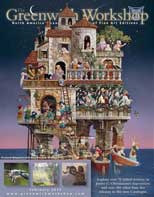
Friedensreich Regentag Dunkelbunt Hundertwasser was born on December 15, 1928. He was an Austrian painter and architect. By the end of the 20th century, he was arguably the best-known living artist in Austria, though he was always controversial. He was born Friedrich Stowasser to a Jewish family in Vienna and attended the Montessori school in 1936. Before he was twenty, all of his relatives on his mother's side had died in the Holocaust. He briefly attended the Vienna Academy of Fine Arts in 1948 and began producing his own art, prints and posters in the late 1940s.
Hundertwasser's original, unruly, sometimes shocking artistic vision expressed itself in pictorial art, architecture, environmentalism, philosophy, stamp and flag design, and clothing design (among other areas). The common themes in his art, prints and posters are a rejection of the straight line, bright colors, organic forms, a reconciliation of humans with nature, and a strong individualism. He remains sui generis, although his architectural work is comparable to Antoni Gaudi in its biomorphic forms and use of tile. He was inspired by the works of Egon Schiele from an early date, and his style was often compared to that of Gustav Klimt. He was fascinated with spirals, and called straight lines "the devil's tools”. He called his theory of art "transautomatism”, based on Surrealist automatism, but focusing on the experience of the viewer, rather than the artist.
Although Hundertwasser first achieved notoriety for his boldly colored art, prints and posters, he is more widely renowned today for his revolutionary architectural designs, which incorporate natural features of the landscape, and use of irregular forms in his building design. Hundertwasserhaus, a low-income apartment block in Vienna, features undulating floors, a roof covered with earth and grass, and large trees growing from inside the rooms, with limbs extending from windows. He took no payment for the design of Hundertwasserhaus, declaring that it was worth it, to "prevent something ugly from going up in its place”. Hundertwasser always considered New Zealand as his official home, and no matter where he went in the world, his watch was always set to New Zealand time. That finally became the place he was buried after his death at sea in 2000.
Friedensreich Hundertwasser Art, Prints and Posters Collection





